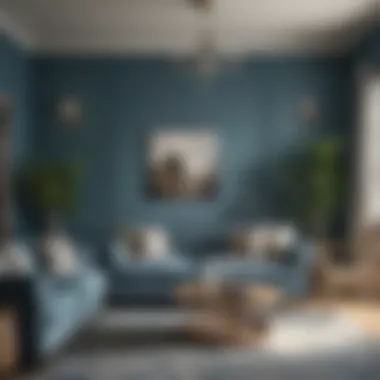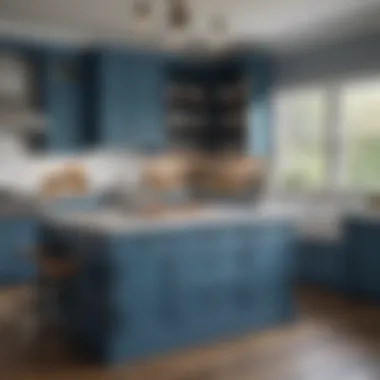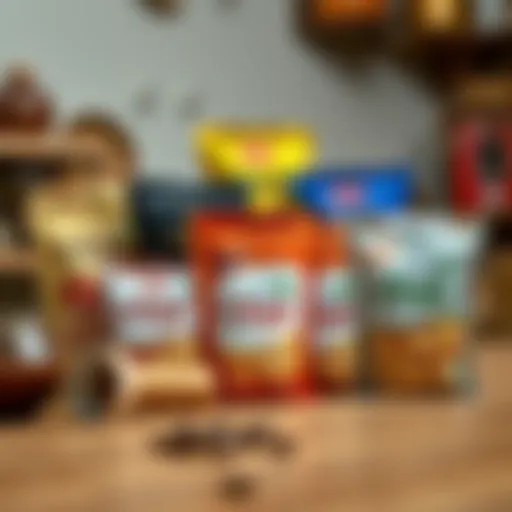Joanna Gaines' Favorite Blue Paint Colors Unveiled


Intro
Joanna Gaines has made an indelible mark on the world of interior design, particularly with her signature use of color. Among her favored shades, blue holds a special place. This article unpacks the nuances of her preferred blue paint colors, highlighting their distinct characteristics. Blue can evoke feelings of calm, serenity, and sophistication in any space.
Understanding the specific shades Joanna chooses gives us insight into her design philosophy. She often considers how colors resonate with the emotions they evoke in people. By examining these choices, we can appreciate how they transform spaces and make them feel more inviting.
Within this exploration, we not only discuss the properties of these colors but also provide practical suggestions on how to incorporate similar hues in our own homes. This guide is structured to enhance your understanding of color in home design. It is tailored for those who wish to use blue to enhance their interiors while keeping in mind the emotional importance of color selection.
Foreword
Color plays a pivotal role in interior design, acting as both a foundation and a finishing touch in the aesthetic of a space. Joanna Gaines, known for her approachable yet sophisticated style, frequently utilizes various shades of blue in her design projects. Her palette not only enhances the physical beauty of a room but also evokes particular moods and emotions. In this article, we will explore Joanna's preferred blue paint colors and their characteristics, application strategies, and overall influence on design aesthetics.
This section establishes the essentials of color selection in home decor. Understanding how each hue influences space helps in creating environments that reflect personal style while maintaining functionality. Joanna's design philosophy emphasizes the balance of elements within any given space. By delving into her favorite shades of blue, we reveal the transformative power of these colors, which can greatly influence the ambiance of a home.
Overview of Joanna Gaines' Design Aesthetic
Joanna Gaines is celebrated for her modern farmhouse style, which seamlessly blends rustic charm with contemporary design. Her approach often highlights natural materials, open spaces, and an emphasis on comfort. Blue, in various shades, fits into this aesthetic perfectly, offering a calming presence amidst the more vibrant elements of her interiors. By selecting specific blue tones, Joanna creates depth without overwhelming a space, allowing the viewer to focus on the craftsmanship and details of the decor.
The integration of blue reflects her belief in designing spaces that feel lived in and welcoming. She often combines blue with other neutrals like whites and grays, enabling a versatile and timeless appeal that resonates with many homeowners.
The Role of Color in Interior Design
Color serves a fundamental purpose in interior design. It acts as a dynamic element that can energize or soothe a space. The appropriate use of color has the power to alter perceptions of volume and space, influencing how a room is experienced.
Blue, in particular, is associated with tranquility and reliability. It often communicates a sense of peace, making it ideal for spaces meant for relaxation, such as bedrooms or living rooms. Understanding how colors interact with light and each other is crucial for making informed design choices. Below are some key points regarding the role of color in interior design:
- Emotional Impact: Different colors evoke various feelings. Blue tends to elicit calmness and serenity.
- Spatial Perception: Lighter shades can make a room feel larger, while darker tones provide coziness and intimacy.
- Cohesion: Colors can tie different elements of decor together, from furniture to artwork.
Overall, the role of color is more than just aesthetic appeal; it shapes experiences and memories in physical spaces.
Understanding Blue in Design
The color blue holds significant importance in interior design, particularly in the context of Joanna Gaines' aesthetic. This section aims to unpack the relevance of blue within her preferred palette. Blue is often associated with tranquility, Serenity, and intelligence. These qualities can have a noticeable impact on the atmosphere of a space, influencing how occupants feel and interact within it.
Understanding how blue fits into various designs aids in making informed decisions about its use in home decoration. From creating a calm retreat to evoking passion and creativity, the way blue is applied can vary significantly.
Another relevant aspect is the versatility of blue. It works well with diverse materials and styles—from modern to rustic. This gives homeowners plenty of options for incorporating blue into their spaces. The emotional resonance of blue is another factor to consider. Different shades can prompt different feelings; this can shape the ambiance and functionality of a room. By understanding these nuances, one can effectively utilize blue to enhance a home's overall design.
Psychology of Blue


The psychology of blue offers insights into why this color appeals to many. Research indicates that blue can lead to feelings of calmness and relaxation. When viewed, it can create a soothing effect, which is why many bedrooms and bathrooms incorporate blue hues. In mental health contexts, blue is often linked to promoting focus and clear thinking, making it a wise choice for home offices.
However, not all blue shades evoke the same sentiment. For example, softer shades may inspire a sense of peace, while bold, deeper blues can sometimes project authority and sophistication. This psychological aspect of blue helps in selecting the right tone for the right environment.
"The choice of color can dramatically influence our mood and behavior."
When aiming for a harmonious space, understanding the psychological impact of blue can guide homeowners in their choices.
Variations of Blue and Their Meanings
The world of blue is extensive, with various shades each carrying unique meanings and uses in design. Understanding these variations can lead to more impactful decor choices.
- Sky Blue: This light, airy shade often brings a feeling of openness and freshness to a space. It’s ideal for smaller rooms to make them feel larger.
- Navy Blue: A darker hue, navy blue conveys a sense of elegance and depth. It works well in spaces intended for entertaining, such as living rooms.
- Light Blue: This shade reflects calmness and tranquility, suitable for bedrooms and wellness areas.
- Teal and Turquoise: These colors blend blue with green, embodying a lively spirit. They add vibrancy and energy to a room, often seen in playful areas like playrooms or creative spaces.
By understanding these variations and their meanings, you can effectively select the shade of blue that aligns best with your design goals.
Joanna's Signature Shades of Blue
Understanding Joanna Gaines' signature shades of blue is essential in appreciating her design ethos. These colors reflect not only her aesthetic preferences but also broader trends in interior design. Each shade carries its own mood, function, and impact on a space. Knowing the characteristics and suggested applications of these blues can help homeowners craft their own unique environments.
Sky Blue
Sky blue captures the essence of a clear sky on a sunlit day. Its calming qualities make it a popular choice for various settings. The lightness of sky blue evokes feelings of tranquility, which can be especially beneficial in spaces meant for relaxation, like bedrooms or reading nooks.
Characteristics of Sky Blue
The dominant aspect of sky blue is its soft hue that promotes serenity. This color can create an airy and expansive feeling, which is advantageous in smaller spaces. Its lightness adds to its appeal, making even cramped quarters feel airy and inviting. However, too much sky blue without complementary colors can feel bland.
Placement in the Home
Sky blue is highly versatile and can fit in many areas of a home. It shines best in rooms where relaxation is key. For example, painting a bedroom in sky blue encourages restfulness. However, overuse may lead to a lack of visual interest. Therefore, combining it with warmer shades can create balance.
Navy Blue
Navy blue offers a striking contrast to the lighter shades of blue. It exudes confidence and sophistication, making it a fitting choice for rooms with a formal or professional air.
Characteristics of Navy Blue
The key characteristic of navy blue is its depth. This richness adds elegance and grandeur to any interior. Navy blue works incredibly well in larger spaces, providing a bold statement. Nonetheless, it can make smaller areas feel confined if used excessively, so moderation is crucial.
Design Applications


Navy blue can be used in various design contexts, from feature walls to accent pieces. Its adaptability makes it suitable for entryways and living rooms. Pairing it with bright whites or warm wood tones can soften its severity, showing its flexibility. In darker rooms, it might be beneficial to include ample lighting to counterbalance its depth.
Light Blue
Light blue retains a gentle appearance, akin to sky blue, but often introduces a slightly different mood. Its soft demeanor plays nicely with both classic and modern designs.
Characteristics of Light Blue
Light blue is noted for its freshness. This shade doesn’t overwhelm a space but instead enhances it, making it appealing for various architectural styles. Additionally, it reflects natural light well, which can brighten up darker corners of a home.
Best Uses in Interior Space
Light blue is ideal for spaces aiming for a serene atmosphere. Bathrooms and kitchens benefit greatly from light blue accents, often working well with white or natural wood furnishings. However, in areas with harsh lighting, light blue can sometimes appear washed out, so it is important to assess light conditions beforehand.
Teal and Turquoise
Teal and turquoise add a different vibrancy to Joanna's palette. These hues stand out and can inject personality into a room while retaining sophistication.
Characteristics of Teal and Turquoise
The striking feature of teal and turquoise is their boldness. These colors can energize a space without being too aggressive. They instill a sense of creativity, making them popular in studios or children's rooms. However, overusing these colors can create visual chaos, so careful balance is necessary.
How to Combine with Other Colors
Combining teal and turquoise with hues like gray, white, or soft yellow can create a balanced environment. Teal pairs well with earth tones, lending a grounding touch to its vibrancy. On the other hand, turquoise often shines alongside warm neutrals, which can soften its assertiveness. When used thoughtfully, these combinations can leave a lasting impact.
Influence of Joanna's Palette
Joanna Gaines' selection of blue paint colors represents more than mere aesthetic choices. They communicate her design philosophy and reflect a broader understanding of how color interacts with space. Blue is not just a color; it serves as a foundation that can shape the mood and appearance of a room. This section explores the significance of her palette, its impact on modern interior design, and offers insights on how these colors serve to create inviting atmospheres in various home settings.
From Magnolia Market to Homes
Joanna Gaines has revolutionized the way people perceive and utilize color in their homes. Her work at Magnolia Market showcases her love for blue tones. Each paint color she selects is purposeful, aiming to evoke feelings of calmness and serenity while remaining stylish and modern. For example, her signature sky blue can create a feeling of openness, making spaces feel larger and more welcoming.
Gaines’ color selections are widely available to the public, allowing homeowners to replicate her aesthetic. This accessibility further influences current trends in home design. By observing her projects, from kitchens to living rooms, the careful choices she makes with blue shades become evident. In these environments, shades like navy or light blue often serve as a perfect backdrop for neutral furnishings, enhancing the overall warmth of the space.
Additionally, her use of blues in changing accents can transform a room's entire feel without major renovations. By minimizing clutter and focusing on color, Joanna directs the eye’s attention, achieving a harmonious balance.
Client Transformations and Testimonials


The influence of Joanna Gaines' blue paint choices extends beyond her own homes. Numerous clients share their stories about how her designs changed their living spaces. Transformations often start with a simple choice of paint that sets the tone for the entire design. Clients frequently mention how choosing a specific shade of blue has impacted their daily lives, fostering a more enjoyable and relaxed environment.
Testimonials highlight the psychological impact that these colors have had within their homes. Many report an enhancement in their mood and overall well-being, attributing it to the serene and inviting spaces created using Joanna's designs. This emotional connection to color is paramount for anyone looking to refresh their home. It’s not just paint; it is about crafting a living experience. Each of these testimonials reaffirms the importance of thoughtful design, which resonates deeply within each space.
Incorporating Joanna's Blue Paint Colors
Incorporating Joanna Gaines' blue paint colors into your home can significantly impact both the aesthetic and emotional ambiance of a space. Joanna's keen sense of style and understanding of color psychology allow her to select hues that resonate well within various environments. The main aspects to consider include balance, light, and the existing decor. Each shade of blue she favors holds potential to enhance a room, making it feel more open or grounded, depending on the context. Choosing the right blue can also reflect personal style and mood, creating a genuine connection between the space and its inhabitants.
Choosing the Right Shade for Your Space
Selecting the right shade of blue requires an understanding of both the room and the desired atmosphere. One must consider the natural light in the space as well as any adjoining rooms. For areas benefiting from abundant sunlight, warmer shades of blue, like light aqua, can help brighten up spaces. In contrast, deeper shades like navy are more suited for rooms with less direct light, as they add depth and coziness. Testing samples on walls at different times of day can provide clarity in selecting the perfect shade.
Complementary Colors and Decor Choices
Best Color Combos
Combining colors effectively can amplify Joanna's blue shades. Using colors like crisp white, muted gray, or warm beige offers a fresh contrast. These colors balance out the boldness of deep blues without overwhelming the senses. Choosing brighter accent shades, such as coral or sunny yellow, can introduce an element of brightness while keeping the blue as the primary focus.
The main characteristic of best color combinations lies in their harmony. They create a cohesive look that feels deliberate and inviting. This concept is especially advantageous for those trying to emulate Joanna’s design philosophy. Applying communal practices like choosing a dominant color and two or three accents can lead to a well-thought-out color scheme that feels unforced.
Furniture Selection
Furniture selection plays a crucial role in fully realizing the potential of blue paint colors. Opting for neutral furniture allows blue walls to stand out. Think about soft materials in muted tones that complement but do not compete with the blue hues. For instance, gray or beige sofas paired with blue walls can offer a gentle contrast that feels comforting.
The key feature of furniture selection is functionality married with aesthetics. Well-chosen pieces not only suit the space's style but also enhance the overall comfort. Whether choosing plush seating or sleek designs, it is important to consider how it matches or contrasts with the painted walls. This careful selection process ensures that the environment is tailored to both taste and purpose.
"Color creates a mood that influences how you feel in your own space."
Overall, Joanna Gaines’ blue paint colors are not just shades but components of a larger design strategy. By carefully incorporating these colors along with complementary choices and thoughtful furniture selection, spaces can be transformed to reflect both personality and style.
Ending
The conclusion of this article emphasizes the significance of understanding Joanna Gaines' favorite blue paint colors and their relevance to modern interior design. These hues do not merely function as aesthetic choices; they play a crucial role in establishing mood, fostering comfort, and creating harmony in living spaces. By examining the characteristics and applications of specific shades, homeowners gain valuable insights into how colors affect both perception and emotion.
Joanna's approach to color is practical yet deeply thoughtful. The shades she favors often invite feelings of tranquility and sophistication, making them suitable for varied applications, from living rooms to bedrooms.
Summary of Key Points
- Psychological Impact: Colors, especially blue, have profound psychological implications. They can influence feelings of calm and relaxation.
- Variations of Blue: Different shades enact different effects. For instance, sky blue inspires freedom, while navy blue might exude authority and elegance.
- Design Applications: Knowing how to combine these shades with other decor elements enhances overall room aesthetics. Joanna’s palette offers various applications that suit diverse environments.
- Practical Considerations: When choosing shades for personal spaces, insights from Joanna’s experiences can guide selections to achieve desired atmospheres.
The exploration also covers the practical elements of integrating blue hues into one’s home. This assists readers in making measured, informed choices, using complex color schemes without sacrificing personal style.
Final Thoughts on Color and Design
Understanding how to implement these colors strategically can lead to transformations that feel personal yet stylistically refined. As noted,
"Color is the keyboard, the eyes are the harmonies, the soul is the piano with many strings."
This speaks to the importance of thoughtful color use in shaping our surroundings. Therefore, leveraging Joanna’s insights on blue paint can ultimately enhance interior spaces while reflecting personal taste.







